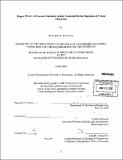Project PEAC : a Personal, Expressive Avatar Controller for the operation of virtual characters
Author(s)
Santos, Kristopher B. dos
DownloadFull printable version (6.329Mb)
Alternative title
Project Personal, Expressive Avatar Controller
Personal, Expressive Avatar Controller for the operation of virtual characters
Other Contributors
Massachusetts Institute of Technology. Dept. of Mechanical Engineering.
Advisor
Cynthia Breazeal.
Terms of use
Metadata
Show full item recordAbstract
The purpose of this thesis was to design and construct a prototype for the control of virtual avatars in a virtual space. It was designed with the intent to feature multiple interfaces such that the user would have many options to control a virtual character. The design was to have kinematic interactions (changing the physical pose of the interface), proximal touch (enabled by capacitive sensing), whole-body movement (enabled by an internal measurement unit), touch pressure (enabled by QTC film), and finger-tip gesture (enabled by a touch screen). After many iterations of a mock prototype, a test was created to determine whether certain affordances of the controller would be used in controlling a virtual character. The mock prototype featured objects that represented the proposed technology for the controller. Participants in the test viewed example animations from two different virtual worlds, and were asked to emulate the actions and emotions shown on the screen. They also rated the controller on the different actions and emotions on a seven point Likert scale for comfort and intuitiveness. It seemed that having a figurine that could pose into the positions for actions and emotions was very helpful and was received well from the ten participants. The other technologies were not used as much, and so the results of this study will assist in redesigning the controller to affectively utilize the given technologies.
Description
Thesis (S.B.)--Massachusetts Institute of Technology, Dept. of Mechanical Engineering, 2010. Cataloged from PDF version of thesis. Includes bibliographical references (p. 45-46).
Date issued
2010Department
Massachusetts Institute of Technology. Department of Mechanical EngineeringPublisher
Massachusetts Institute of Technology
Keywords
Mechanical Engineering.